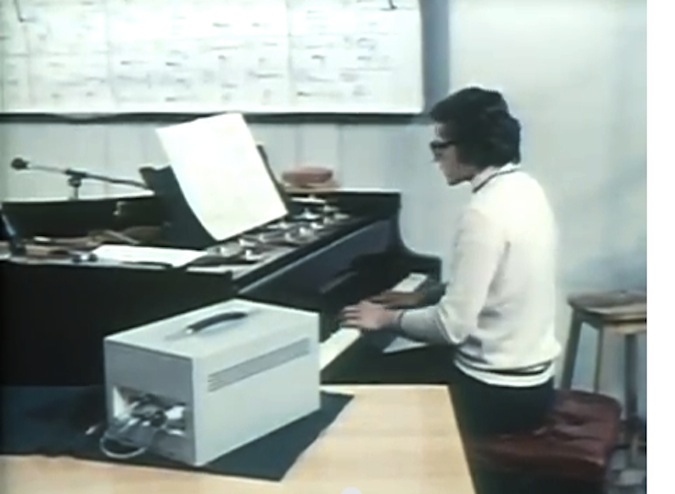
Fig. 1. Modul 69 B. Still from Karlheinz Stockhausen, British Lectures (1972-73). Allied Artists, London.
This guide outlines an approach to realising the live electronics component of Stockhausen's MANTRA (1970). It stems from my development of new hardware and software for the work, as part of a project with Plus-Minus Ensemble. (The results of the project are documented on a recording — with pianists Mark Knoop and Roderick Chadwick — on Hat Hut Records.) The guide is written in the hope that it will lead to further uptake of the work, at a time in which new realisations are becoming increasingly unfeasible and impractical (due largely to the 'ageing' of the analogue technology for which the work was originally composed). The key objective behind my approach was to create a cheap, lightweight, and highly portable system which was as faithful as possble to the analogue sound and feel of the original.
MANTRA was originally composed for a matched pair of custom analogue ring-modulation devices. Stockhausen sets out the broad specifications in the Preface to the score [4, p.iv]:
A special modulator MODUL 69 B was built for MANTRA to the composer's specification by the firm of Lawo in Rastatt, near Baden-Baden.
This piece of equipment has 3 microphone inputs with regulable microphone amplifiers, compressor, filters, sine-wave generator and a particularly refined ring modulator.
No frequencies are written on the sine-wave generator dial; there are just the numbers 1 - 12 (13 = 1), in the order they are tuned to. If the 2 grand pianos are tuned to a1 = 440 Hz, then the pitch a, which is given the numbers 1 and 13 in the following enumeration, must match 220 Hz on the sine-wave generator. If the pianos are tuned differently, then the scaling of the sine-wave generators must be altered accordingly. Because of certain glissandi prescribed in the score, the sine-wave generators must be so-called beat frequency oscillators, with frequencies continuously variable between 3 Hz and 6 000 Hz.
The MODUL 69 B was a bulky all-in-one unit:

Fig. 1. Modul 69 B. Still from Karlheinz Stockhausen, British Lectures (1972-73). Allied Artists, London.
One of the advantages of moving the realisation of the work from the analogue to the digital domain is that the performance interface and the audio processing subsystem are easily decoupled. This allows for a lightweight and streamlined performance interface for the pianists. I built two, slightly different control boxes for Mantra:
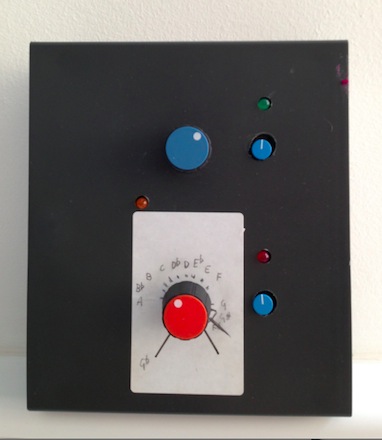 |
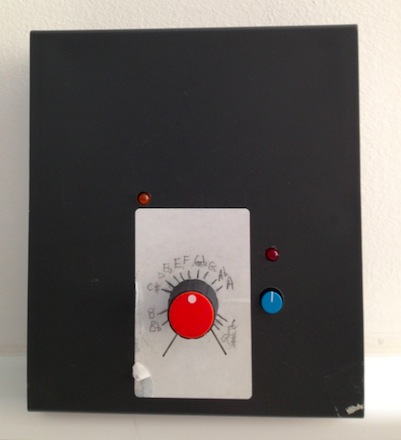 |
| Fig. 2. Piano 1 control box | Fig. 3. Piano 2 control box |
The control boxes communicate with the host computer over the ZigBee wireless serial protocol. I designed and built a custom circuit based around the ATmega8 AVR microcontroller and the XBee-PRO ZB radio modem. Because the two control boxes are slightly different, two separate programs were written for the microcontrollers.
Designing and building a custom circuit takes more effort than is really necessary for the requirements of MANTRA. A circuit with identical functionality to mine — and with only a very slightly larger footprint — can be assembled from the combination of an Arduino board and Wireless Shield. The Wireless Shield will happily house the XBee, for which there's a driver in the basic Arduino library.
The reasons for choosing wireless over more standard protocols (e.g. MIDI, OSC) were straightforward:
The two control boxes share the same set of basic interface components:
The control box for Piano 1 has the following additional components:
Through most of the work, the pianists tune the sine wave oscillators to one of 12 target frequencies, with occasional glissandi motions between and around them:
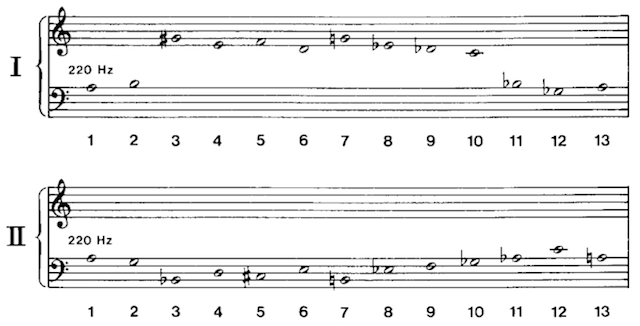
Fig. 4. The 12 target frequencies for Piano 1 (top) and Piano 2 (bottom). Note: Frequency no. 13 is identical to frequency no. 1.
To accommodate the greatest freedom of movement in the knob actions, the entire compass of the knobs was used when the control boxes were sending data in 'Normal Mode'. The mapping into appropriate ranges for both Pianos is set out in the two figures below. Note that 'notches' are interpolated into the tables around each target frequency, to allow for quick and precise tuning. When the knobs move into positions corresponding to the 'target frequency' plateau regions, the host computer sends a signal to the control box to illuminate the orange ('Target Frequency') LED.
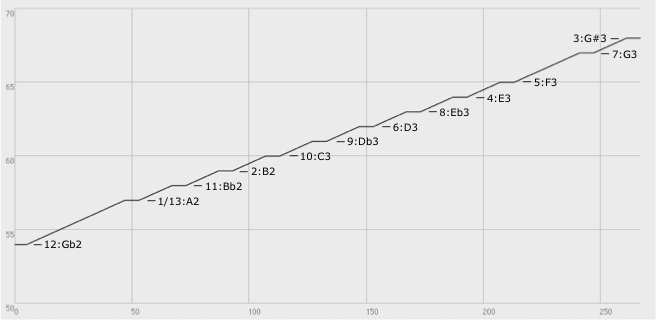
Fig. 5. Piano 1 'Normal Mode' mapping table. X-axis: 8-bit control numbers (knob position). Y-axis: midi note numbers (60 = middle C = C3).
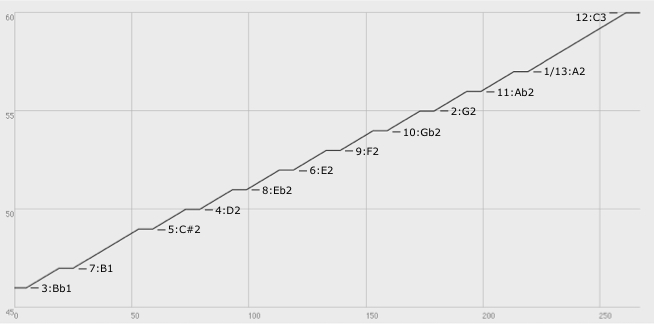
Fig. 6. Piano 2 'Normal Mode' mapping table. X-axis: 8-bit control numbers (knob position). Y-axis: midi note numbers (60 = middle C = C3).
At various points throughout MANTRA, the frequency range of the sine wave oscillators extend beyond that of 'Normal Mode', encompassing large spans of the 3 Hz - 6 kHz total range of the MODUL 69 B. The specific sections are:
The solution adopted for these sections is borrowed and adapted from Pestova et al. [2]: the 'Extended Mode' toggle on the control box switches between the 'Normal Mode' mapping (Figs. 5 and 6) and an extended continuous mapping throughout the entire range of 2.5 Hz - 6 kHz. When 'Extended Mode' is active, the red ('Extended Mode') LED on the control box is illuminated, and the orange ('Target Frequency') LED is disabled.
In the section between mm. 582-611, Piano 1 is asked to operate 'a short-wave receiver or a tape recorder with a volume control' [4, p.iv]. An extra button is added to the Piano 1 control box for switching emulated shortwave sounds on at the host computer (detailed in the Audio Processing section), and an extra knob is added for real-time control of volume. When 'Shortwave Mode' is active, the green ('Shortwave Mode') LED on the Piano 1 control box is illuminated.
The audio processing network for the ring modulation in MANTRA is straightforward:
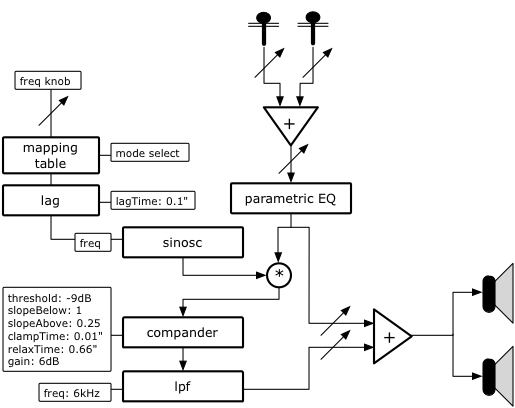
Fig. 7. Ring modulation audio processing network for each of the two pianos.
SynthDef('ringmod', { |pno1Mode=0, pno2Mode=0|
var in, src, pno1Mod, pno1Norm, pno1Ext, pno2Mod, pno2Norm, pno2Ext;
/* snip: pno1Norm, pno1Ext, pno2Norm, pno2Ext mapping tables excluded here */
pno1Mod = Lag3.kr(Index.kr(Select.kr([pno1Norm, pno1Ext], pno1Mode), In.kr(0)), 0.1);
pno2Mod = Lag3.kr(Index.kr(Select.kr([pno2Norm, pno2Ext], pno2Mode), In.kr(1)), 0.1);
in = In.ar(8, 2);
src = in * SinOsc.ar([pno2Mod, pno1Mod].midicps);
src = CompanderD.ar(src, -9.dbamp, 1, 0.25, 0.01, 0.66, 6.dbamp);
src = LPF.ar(src, 6000);
Out.ar(0, src); // ring mod
Out.ar(2, in); // dry
});
Fig. 8. SuperCollider synthdef for the ring modulation section. Note: The mapping tables are excluded for concision. The full code is available here.
An interpolating lag filter is placed after the frequency mapping table, to smooth the glissando motions. A 2nd-order low pass filter is placed after the ring modulation section, to achieve a more 'analogue' frequency response. Stockhausen does not specify compression settings, but I found those specified in Fig. 7 to provide the best results in most situations. A parametric equaliser is placed immediately after the input to compensate for anomalies in room, microphone, and/or loudspeaker frequency response. Sideband aliasing was not found to be a problem while working on the piece, provided the sample rate was set sufficiently high (96 kHz is more than adequate).
Stockhausen stipulates that Piano 1 is to operate 'a short-wave receiver or a tape recorder with a volume control' [3, iv] during the 'Shortwave section' of the work (mm. 582-611). Rather than use a stock recording, I decided to design a 'shortwave emulator', to allow for the degree of variability and dynamic behaviour that a shortwave radio would bring in performance. (There were a number of reasons why an actual shortwave receiver was not practical, including the relative scarcity of shortwave radio transmissions one is able to find today (as compared to ca. 1970), as well as the highly effective shielding from radio signals in place in most contemporary concert spaces.) The emulator is based on analyses of the spectral and temporal/rhythmic behaviour of various recordings of shortwave broadcasts. The audio processing network is too unwiedly to capture in a signal flow diagram. The SuperCollider synthdef is as follows:
SynthDef('shortwave', {
var level, sw1, sw1_d, sw1_f, sw1_t, sw2, sw2_d, sw2_t;
level = Lag3.kr(In.kr(2).linlin(0, 1, -30, 0), 0.1).dbamp;
sw1_d = Drand(({ rrand(0.02, 0.04) } ! 23), inf);
sw1_t = Duty.kr(sw1_d, 0, Dseq([1, 0], inf));
sw1_f = TChoose.kr(sw1_t, [1240, 2400, 2450]) + ({ LFDNoise3.kr(0.3, 40) } ! 3);
sw1 = SinOsc.ar(Lag3.kr(sw1_f, 0.01), 0, LFDNoise3.kr(0.3).range(-36, -24).dbamp);
sw1 = sw1 * Lag3.kr(Trig.kr(sw1_t, sw1_d), 0.01);
sw1 = PitchShift.ar(sw1, 0.1, 1, 0.005, 0.005);
sw2_d = Dxrand([0.6] ++ ({ rrand(0.02, 0.09) } ! 15), inf);
sw2_t = Duty.kr(sw2_d, 0, Dseq([1, 0], inf));
sw2 = SinOsc.ar(960 + LFDNoise3.kr(0.2, 25), 0, -21.dbamp);
sw2 = sw2 * Lag3.kr(Trig.kr(sw2_t, TWChoose.kr(sw2_t, [0.04, 0.09], [0.7, 0.3])), 0.005);
Out.ar(4, Mix([sw1, sw2]) * level);
});
Fig. 9. SuperCollider synthdef for the shortwave section. The code is also available here.
In addition to the routine task of ensuring good sound and balance, the sound projectionist in MANTRA plays a key role in characterising distinct textural regions, and in providing a degree of definition to the overall form. Stockhausen alludes to these aspects in the Preface to the score [4, p.v]:
The mixing of the amplified direct sound and the ring-modulated sound of the two pianos, and the regulation of the volume level of both groups of loudspeakers from the middle of the hall, during performance, necessiates a musical assistant who knows the dynamics of the composition well enough to be able to operate the potentiometers parallel to the actual playing. Because of the compression which is necessary, the ring-modulated sound doesn't sink below mezzo piano, and so it is essential, particularly during soft passages, to lower the volume of the loudspeakers sufficiently for one to be able to hear something of the unamplified direct sound. It is also necessary to adjust the level of the ring-modulated sound in the extreme registers: in loud, low passages the ring-modulated sound must normally be reduced because of feedback, whereas in the extreme high registers it will mainly be raised.
Many indications are provided for precise level adjustments within the score, as well as in the 1975 errata [5]. These adjustments should, however, be considered context-dependent: they provide a clear guide to the various shifts in dynamic balance and contour, but remain highly variable with respect to differences (between pianos, microphones, amplifiers, loudspeakers, room characteristics, etc.) from one performance situation to the next.
Stockhausen had a clear position on piano amplification: 'I actually want everyone to hear the piano as the pianist hears it' [6, p.81]. This suggest two key factors: 1. that the sound should be 'up close', with the percussive qualities of the hammer action accentuated, and with the attack transients highlighted, and 2. that there should be some left-to-right spread over the stereo image corresponding to the low-to-high spread of the piano keys (with middle C roughly in the center of the image).
Stockhausen describes a set-up that achieves this result [6, p.80]:
For all piano amplification I use two microphones. One of these I position over the last metal bars in the highest octave of the grand piano at a distance of about 15 cm, aimed perpendicularly downwards, and the second is next to it, aimed obliquely downwards at the middle A, by which means the bass region is amplified.
In rehearsals of my work Mantra, for two pianos, in which 2 x 2 microphones are always used for amplification of the direct sound and for ring-modulation, I have sometimes noticed that sound-technicians place microphones in the resonance holes of the grand piano or in quite different places. Whenever I myself have been responsible for the sound projection, I have placed the microphones as I have just now described. In all performances of works with piano I mike the piano with two microphones.
In combination with high quality condensor cardioid mics, this configuration produces good results. Recommended mics are Neumann KM 184, Gefell M300, Schoeps MK 4, Earthworks SR 40.
Stockhausen provides clear instructions on loudspeaker setup in the Preface to the score. The setup is largely consistent with that for which he advocates as 'a general rule of thumb' in stereo configurations [6, p.78]:
Four loudspeakers must be used for the projection of the sound, and this is actually important for all amplification technique. If you wish to produce a stereo panorama, in which the sound will be heard from the place where you see the musician, there must be two loudspeakers placed on the right and two on the left at the sides of the platform, about 3.5 meters higher than the instruments. The outermost of both pairs of loudspeakers must be aimed approximately in the direction of the mixing console; the two inner loudspeakers must be adjusted so that the right one is aimed at the leftmost seat of approximately the third row in the audience, and the left one at the last seat on the right of the third row. Only in this way is it possible for the people sitting on the right to hear things in the left of the stereo panorama, and those sitting on the left to hear things from the right.
A fifth loudspeaker should also be used for projection of the shortwave sounds. As per Stockhausen's specification, this loudspeaker should be placed inconspicuously behind Piano 1.
[1] Cott, Jonathan. 1973. Stockhausen: Conversations with the Composer. New York: Simon and Schuster.
[2] Pestova, Xenia, M. T. Marshall, J. Sudol. 2008. "Analogue to digital: Authenticity vs. sustainability in Stockhausen's Mantra (1970)". In Proceedings of the International Computer Music Conference, Belfast, 2008. ICMA and The Queen's University.
[3] Stockhausen, Karlheinz. 1975. MANTRA für 2 Pianoen (1970), Werk Nr. 32 (score). Kürten: Stockhausen-Verlag.
[4] Stockhausen, Karlheinz. 1978. "MANTRA, für 2 Pianoen (1970)". In Karlheinz Stockhausen, Texte zur Musik 4, ed. Christoph von Blumröder, 154-66. DuMont Dokumente. Köln: DuMont Buchverlag.
[5] Stockhausen, Karlheinz. 1975 [2009]. "MANTRA: Errata in the first edition". Kürten: Stockhausen-Verlag. Accessed 11 May 2013.
[6] Stockhausen, Karlheinz, Jerome Kohl. 1996. "Electroacoustic Performance Practice". Perspectives of New Music 34:1 (Winter, 1996), pp. 74-105.
[7] Stockhausen, Karlheinz, unnamed authors. ND. "Sound Projection Course Basics". Document produced for the Stockhausen Courses, Kürten. Accessed 11 May 2013.